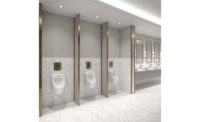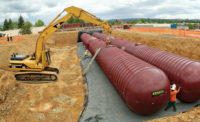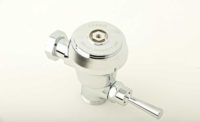Restrooms in airports and train stations face a unique set of challenges.
Not only do they have to just withstand the high traffic that comes with the thousands of travelers passing through each day, but these facilities must also present a travel-friendly experience greeting users with sustainability and style.
As a result, airports, train stations and other transportation buildings worldwide are engineering innovative solutions to promote strategic design, hygiene, sustainability and the ultimate travel experience.
Avoiding traffic jams
Public transit restrooms experience some of the highest foot traffic of any public buildings, making traffic flow a top consideration when designing these projects. In fact, at Chicago’s O’Hare International Airport alone, 83.4 million passengers passed through the terminal in 2018 (according to the Chicago Tribune). Engineers and designers are turning to commercial restroom products to facilitate getting users in and out of these restrooms as quickly as possible – all while ensuring they have a pleasant experience.
Integrated sink designs are now combining the faucet, soap dispenser and hand dryer into one location in order to streamline the handwashing process, al-lowing users to complete their handwash without ever having to move their feet. Accommodating almost 75 million passengers in 2016, the Los Angeles Interna-tional Airport (LAX) specified these integrated sink systems to help fast-track handwashing for travelers. The sink system was further customized to include icons that easily communicated “soap dispenser,” “faucet” and “hand dryer” to international travelers. This all-in-one handwashing system keeps soap and water from splashing onto the ground to not only guard against sticky floors and countertops, but also minimize the risks associated with slipping and falling.
Additionally, an out-of-order water closet or urinal equates to one less fixture in operation, and in turn, a longer wait for users. Sensor-operated products of all types – especially flushometers – make sure the contents are evacuated after each use to keep them up and running.
It’s not just restroom fixtures that are helping to move traffic in airports and train stations. No weary traveler wants to wait in line or maneuver in and out of a cramped stall with crowded restroom luggage, or worse, prop their luggage unattended outside their stall or near a urinal. That’s why hooks, shelving and larger stalls – with outward-swing doors – are an evolving trend in these crowded commercial restroom spaces.
It’s also crucial to know how many restrooms to have onsite. The recommended ratio of EQA (equivalent aircraft capacity) to airport restrooms is 8:1. With one EQA equaling roughly 145 seats, each concourse should have one restroom for each gender for every 1,160 passengers of gate capacity.
Hygiene helpers
Restrooms can be a breeding ground for germs, especially with thousands of people going in and out of them every day. The high usage of public transporta-tion restrooms presents a great opportunity to prevent the spread of germs thanks to touch-free experiences that start as soon as users enter the restroom.
The touch-free trend began with a focus on sensor-operated fixtures such as flushometers, faucets, soap dispensers and hand dryers, yet users were still faced with the need to touch the restroom door upon exiting. The solution then became to use paper towels to open the door, but that only led to increased paper towel usage that would litter the restroom floor. To avoid those problems, designers are now adding walk-around privacy corners instead of doors. These corners add the needed privacy for the restroom space, while also enhancing the touch-free experience for the user.
It’s no surprise that the less users are required to touch fixtures in the restroom, the fewer germs they leave behind and the less interaction they have with exist-ing bacteria. From the flushometer to the faucet, sensor-activated fixtures in the restroom help promote a hygiene-friendly environment. Specifically, sen-sor-operated flushometers can help mitigate poor user behavior such as forgetting to flush the water closet after use.
All aboard for water conservation
Water usage really adds up with such a high volume of travelers frequenting the restrooms at airports and train stations. That’s why architects and de-signers are turning to low-flow flushometers that reduce water volume and increase sustainability. After a recent retrofit in which Los Angeles Union Station specified new automatic dual-flush technology to accommodate its 100,000 passengers per day, the historic facility is now reducing water usage by up to 30% in its bathrooms, it reports.
Innovative technology is now providing facility managers with low-flow, touch-free fixture options to save on both water and maintenance costs. Thanks to Bluetooth technology, one such smartphone application enables building owners and facility managers to collect data and adjust settings without having to get under the sink or spend time working on the restroom floor.
As facility managers are given the ability to determine exactly how much water they can both save and utilize without sacrificing performance, this type of predictive maintenance helps transportation facility managers attain water savings with much better precision while offering users an efficient, high-quality re-stroom experience.




